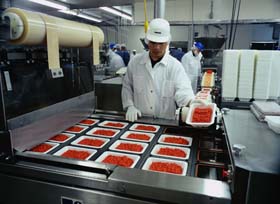Fresh Meat Blooming in Grocery Store and Butcher Merchandisers

Myoglobin is a protein pigment that stores and carries oxygen for muscle tissue metabolism. It contains an iron atom that can bind with oxygen, water, or nitric oxide (responsible for the color of cured meats) and can oxidize (lose an electron), chemical reactions that cause the color of fresh meat to change.
In several studies it has been found that color is very important to consumers when they select meat; for beef the ideal color is bright cherry red; for lamb, dark cherry red; for pork, grayish pink; and for veal, pale pink. These colors are achieved by allowing the fresh meat to bloom.
In a freshly slaughtered animal, myoglobin is purple, which gives the meat a dark purplish hue. The meat is often preserved at this color by packaging it in airtight, dark containers while the meat is stored or transported. Within half an hour of exposure to oxygen and light, the meat blooms: myoglobin becomes oxygenated as oxygen is absorbed by the meat and binds to the iron atom, forming oxymyoglobin, a characteristically red pigment that causes the meat to turn from purple to the appropriate shade of red or pink.
The exact shade of red is determined by the amount of myoglobin in the muscle tissue, which can vary depending upon the animal’s diet, age, sex, and species, and the amount of exercise it had. Meat from older animals and meat from muscles that were strengthened through exercise tend to be darker. Thus beef, which has a higher concentration of myoglobin than pork, lamb, or chicken, is bright cherry red, while veal from a milk-fed penned calf and pork are pale pink.
While this oxygenation is reversible, and the meat pigments fluctuate between these two purple and red colors regularly, other reactions soon become more predominant. The blooming period is therefore short-lived, but can be prolonged by minimizing the exposure to ultraviolet and visible spectrum radiation, maintaining low temperatures, and using modified atmosphere packaging (MAP) containing very high concentrations of oxygen.
